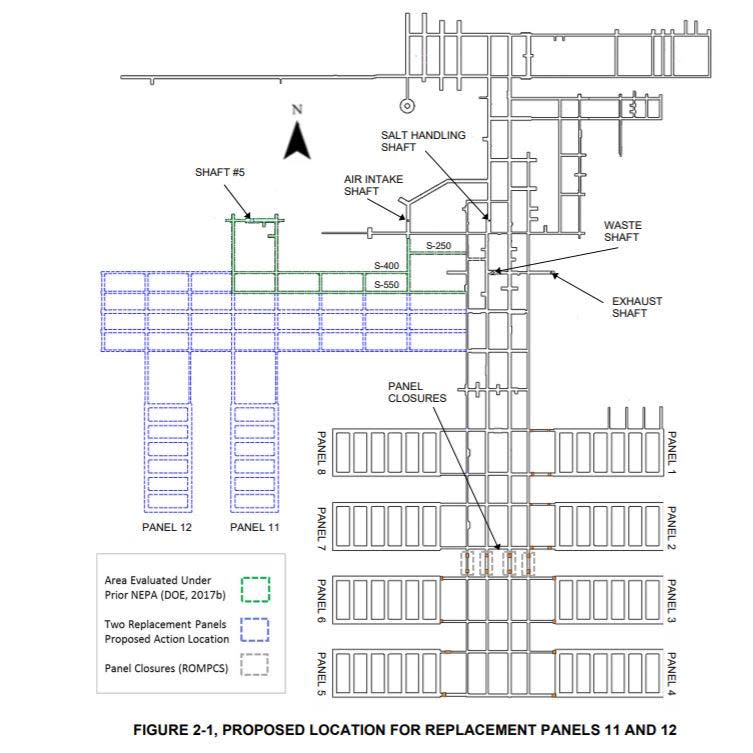The WIPP facility near Carlsbad will mine new space to dispose of nuclear waste
More space is coming to dispose of nuclear waste at a Carlsbad-area facility where the materials from around the country are buried thousands of feet underground.
The Waste Isolation Pilot Plant was initially permitted for eight disposal panels, where drums of transuranic (TRU) nuclear waste is disposed of via burial in an underground salt deposit about 2,000 feet beneath the surface.
But in 2014, a drum of waste ruptured and left portions of WIPP’s underground contaminated and unusable for further waste disposal.
More: Federal budget talks could endanger Holtec nuclear waste site near Carlsbad
That’s why the U.S. Department of Energy sought to mine two additional panels as it works toward WIPP’s volume of capacity of 6.2 million cubic feet of waste.
The repository, the only in the U.S., is used to dispose of TRU waste – clothing, equipment and other debris irradiated during nuclear activities – produced at DOE facilities and national laboratories around the country.
To keep that work going, WIPP officials sought and received language in the facility’s permit with the State of New Mexico to mine and use two more panels, as the permit was recently renewed for another 10 years.
More: Why did so much of WIPP's 479 nuclear waste shipments in 2023 come from Idaho?
It will be the first time in about a decade that a new panel was being mined at WIPP, after the 2014 incident put completing the eighth panel on hold.
Ahead of the disposal panels themselves, work was already underway to mine access drifts that will connect them to the rest of the underground, and tie into a new utility shaft that will draw air into the mine.
DOE officials maintained the new panels were merely replacing space lost in 2014, and the site’s overall capacity was unchanged.

More: Nuke weapons waste disposal using Waste Isolation Pilot Plant to have 'negligible impact'
“The new panel does not represent an increase in the scope of WIPP’s effort, as the waste emplaced in Panel 11 will be entirely part of the original Congressional volume limits established for WIPP,” read a statement from the DOE.
Michael Gerle, environmental regulatory compliance manager at the DOE’s Carlsbad Field Office said the agency worked closely with the New Mexico Environment Department and others in planning the new panels.
“The successful start to mining Panel 11 was a great demonstration of how open dialogue and communication with our regulators and stakeholders, along with the support of the field office team, can help mission success,” he said.
More: Cold War nuclear waste is prioritized at Carlsbad-area repository. How much is there?
The permit also stated that the second of the two new panels, known as Panel 12, would be reserved for “legacy waste” leftover from the Cold War and held at Los Alamos National Laboratory in response to other concerns voiced by advocacy groups.
Those fears were related to a project by the DOE to increase production of plutonium pits at Los Alamos and the Savannah River Site in South Carolina, work that would generate new waste streams for disposal at WIPP potentially outside the original scope of the facility.
WIPP opponents argued these two panels should be the last added to WIPP, amid potential plans the DOE could add up to seven more for a total of 19 panels, according to a 2022 report from the Government Accountability Office.
More: Cable snaps inside utility shaft at WIPP, pausing work for now
“We understand we’re still dealing with consequences of that explosion in 2024. They need to replace the space lost to fulfill their mission,” said Cindy Weehler with advocacy group and WIPP critic 285 All. “What we don’t approve of is any more panels being excavated because we know that is for new waste. We know the DOE is planning that.”
She pointed to another recent DOE project to dispose of diluted surplus plutonium at WIPP as another in a series of potentially new waste stream Weehler said the WIPP site was not intended for.
“Use WIPP for what it was intended for, but don’t bring new waste that was not approved,” Weehler said. “We don’t think it should be expanded.”
More: Final testing underway at $486M air system for nuclear waste site near Carlsbad
She said closure date should be set in WIPP’s permit, to limit the risk the site poses to New Mexico.
Language in the NMED also called on the DOE to file an annual report with the State, citing progress toward finding a new repository once WIPP is full and closed.
“We want to make sure people know how dangerous it is to keep adding to this one site,” Weehler said. “There is not closure date right now, and we oppose that.”
Adrian Hedden can be reached at 575-628-5516, achedden@currentargus.com or @AdrianHedden on the social media platform X.
This article originally appeared on Carlsbad Current-Argus: More space mined at WIPP for nuclear waste disposal near Carlsbad

